Revista Electrónica de Investigación Educativa
Vol. 13, Num. 1, 2011
L2 Phonology Learning among Young-Adult Learners
of English: Effects of Regular Classroom-based
Instruction and L2 Proficiency1
Diana Morales Pech
diana1083@hotmail.com
Universidad Tecnológica de Cancún
Carretera Cancún-Aeropuerto, Km. 11.5
S. M. 299, Mz. 5, Lt 1, 77500
Cancún, Quintana Roo, México
Jesús Izquierdo
jesus.izquierdo@mail.mcgill.ca
Universidad Juárez Autónoma de Tabasco
Zona de la Cultura, Av. Universidad S/N
Zona Centro, 86040
Villahermosa, Tabasco, México
(Received: September 27, 2010;
accepted for publishing: January 26, 2011)
Abstract
Using a mixed methodology, this study examines the impact of a university-level English phonology course on the acquisition of vowel and consonant sounds in that language, by beginning (n = 4), pre-intermediate (n = 8) and intermediate-level (n = 6) students. The 5-hour-a-week, 16-week course was taught by teacher of English. To determine the effects of the course, students participated in two oral activities during an interview at the beginning of the course, and another at the end. During these interview, nine classes were observed, and the instructor reported the activities implemented. The analysis of variance revealed positive changes in all the students’ pronunciation students. Observations and reports verified the presence of systematic and focused phonological teaching through a variety of activities. The results suggest that this type of teaching allows students to counteract the negative effects which biological factors and the influence of the mother tongue have on learning.
Key words: Second language teaching, English phonology, student development.
Introduction
During second-language (L2) learning, students need to gain control over a wide array of new linguistic features which include morphology; syntax; vocabulary; phonology; productive and receptive strategies; and socio-pragmatic competence (Lyster, 2007). L2 research has provided robust evidence that over time, L2-classroom learners can achieve native-like mastery of L2 elements such as morphology, syntax and vocabulary (Lightbown & Spada, 2006). However, less successful results have been documented concerning L2 phonology among adult learners. Among these learners, two factors hinder the acquisition of L2 phonology. One factor relates to biological constraints resulting from age (Brown, 2007; Long, 1990; Scovel, 1988). L2 research has presented evidence of a negative correlation between age and the attainment of native-like pronunciation. Various explanations have been suggested for this correlation. Lenneberg (1967) stated that after the end of brain function lateralization, language learning takes place with effort; he proposed the existence of a critical period for language learning2, after which the attainment of native-like L2 phonology is difficult.
Three theoretical models have been offered to explain the role of age in L2-phonology acquisition: Kuhl’s Native Language Magnet Model (1992); Best’s Perceptual Assimilation Model (PAM)(1994); and Flege’s Speech Learning Model (1995). While these models differ in their categorization of the perceptual representations of the first language (L1), and L2 phonetic and phonological patterns in the brain, they share the notion that with age, there comes a decline in the ability to distinguish new L2 sounds which are similar to those of the learners’ L1. Flege (1995) explained that sounds which are similar but slightly different in the L1 and L2, are difficult to acquire, since the new L2 sounds can be confused with the familiar L1 sounds. Despite this diminution in sound perception in the L2, the model’s proponents stated that the necessary mechanisms for producing L2 phonological features remain intact.
In terms of L1 influence, Ellis (2003) has stated that in the literature on second language acquisition there is now strong evidence that the learners’ mother tongue plays a major role in the acquisition of L2 features (e.g., Izquierdo & Collins, 2008; Izquierdo, 2009). In the case of L2-phonology acquisition, research has shown that similarities between the learners' L1 and L2 sound systems influence L2 sound perception and production (Best, 1992; Flege, 1995). According to Flege (1995), L2 sounds that are similar to L1 sounds are not easy to acquire because they are perceived as L1 equivalents. Indeed, evidence to support this argument comes from a study conducted by Flege (1991). In this study the perception of English vowels among native Spanish speakers was investigated. For instance, the results showed that ESL learners perceived the English vowel /æ/ as the Spanish vowel /a/. Dissimilar sounds were easier to acquire because of their noticeable differences (Oller & Ziahosseiny, 1970). Major (2008) adds that “minimal differences often go unnoticed” (p. 65). Congruent with this argument, Bohn and Flege (1992) provided evidence that German learners of English produced the English vowels /i/ /I/ / / with difficulty because German contains equivalent or similar phones. However, the participants produced the sound /æ/ with success, as this sound did not have a related phone in German. In light of the results of this and other studies, Derwing and Munro (2005) have suggested that English instructors provide learners with opportunities to notice how the phonological system of their L1 differs from that of the L2.
/ with difficulty because German contains equivalent or similar phones. However, the participants produced the sound /æ/ with success, as this sound did not have a related phone in German. In light of the results of this and other studies, Derwing and Munro (2005) have suggested that English instructors provide learners with opportunities to notice how the phonological system of their L1 differs from that of the L2.
In line with Derwing and Munro’s (2005) suggestion, there is evidence that instruction can lead to the improvement of L2 pronunciation at the segmental and suprasegmental levels (Derwing, 2008). The segmental level has to do with the pronunciation of phones in isolation, whereas the suprasegmental level encompasses the production of phones in combination with other sounds within words or sentences. To examine the effects of instruction, Derwing, Munro and Wiebe (1997) exposed 12 advanced learners of English to 12 weeks of suprasegmental instruction. The participants had lived in an English-speaking country for over 10 years. Before and after the instruction, speech samples were obtained from the participants. Analyses revealed that the participants had improved their intelligibility and comprehensibility, and had reduced their accentedness. In a follow-up study, Derwing, Munro and Wiebe (1998) examined the effects of three different types of instruction on the L2 pronunciation of three groups of ESL learners. Group 1 received segmental instruction; Group 2 received suprasegmental instruction; and Group 3 received instruction on L2 skills without pronunciation instruction. Learners' L2 pronunciation was documented through sentence and narrative production before and after receiving instruction. In the results, the group receiving segmental instruction showed improvement in the pronunciation of sounds in sentences, whereas the group receiving suprasegmental instruction had improved their pronunciation of sounds in narratives.
Pennington, Ellis, Lee, Lau, and Lock (2002) also examined the effects of instruction/treatment derived from seven different pedagogical orientations:
- Participants listened to a set of sentences without repeating them, while seeing the written form on a computer screen.
- Participants identified the intonation of the sentences.
- Participants received a written explanation of the types of sentences, accompanied by a spoken version demonstrating the intonation.
- Participants repeated each sentence three times while looking at the sentence on a screen.
- Participants repeated the sentences while speech-analysis equipment showed them simplified tracings on a screen above the written sentence while it was being spoken.
- A pitch contour of each spoken sentence was extracted by means of the Signalize speech-analysis system, after which the pitch-contour input was provided as audio files. Students listened to a playback of the extracted contours while viewing the written version on the screen.
- Finally, participants monitored their own spoken intonation by means of computerized analysis equipment. This equipment showed the contour of this intonation on a screen; participants could repeat the sentences at will, so as to match their intonation with the correct one.
Improvement was observed after instruction/treatment 5, where repetition was complemented with a visual representation of intonation contour; and after treatment 6, where repetition was complemented with an extracted auditory pitch contour. Those receiving treatments 5 and 6 showed improvement in sentence intonation, such as falling voice in Wh-questions, and rising voice in Echo Questions.
In summary, the studies above showed that instruction can help adult learners overcome segmental or suprasegmental L2-pronunciation learning challenges. To date, however, research has investigated the beneficial effects of instruction with homogeneous L2 proficiency groups in laboratory contexts only. The objective of the current study was to extend the scope of research on the effects of instruction in L2 phonology. We sought to identify the effects of regular classroom-based phonology instruction, given over the 80 hours of a full term (i.e., 5 hours every week for a period of 16 weeks), on the pronunciation of both consonant and vowel sounds in the L2, on learners having various levels of L2 proficiency.
II. Methodology
To achieve our objective, a mixed-method descriptive classroom-based study was conducted. Participants were observed over 16 weeks, while receiving regular phonological instruction in class. During the study, two quantitative and two qualitative instruments were used to document the manner in which this classroom-based instruction was expected to lead to changes in the learners’ pronunciation of three L2-consonant and two L2-vowel sounds.
Participants & Context. The participants in this study were enrolled in a five-year B. A. program in Language Studies in Southeast Mexico during the Fall of 2008. In this program, learners simultaneously learned English, French and Italian. The participants were enrolled in an English Phonetics and Phonology course, taught during the second half of the program’s second year; all the participants belonged to the same class. The data of the 18 participants enrolled in this course were examined in the current study. There were 13 female and 5 male students ranging in age from 19 to 30 years. At the time of the study, some participants (n = 9) were already taking courses with the content in English; twelve learners had taken English courses in different language institutions. None of the participants had received instruction on the phonology of any of the L2s.
Participants’ English Proficiency. In a meta-analysis of L2 research studies, Norris and Ortega (2000) observed that the L2 language proficiency of learners can be determined through a variety of tasks that elicit their declarative and/or automatized knowledge of the L2 system. This knowledge can relate to morphology, syntax, vocabulary, etc., and provides a reference point for categorizing learners with regard to their acquisition of the L2. Thus, for the purpose of the current study, the L2 proficiency of the learners was operationalized through a combined measurement of their English vocabulary and grammar. This measurement was obtained based on the learners’ scores on an adapted version of the international, standardized Michigan English Test (Hinenoya, 2008), which was administered at the beginning of the course. The first test section evaluated grammar, whereas the second section assessed vocabulary; each section included 40 items. To establish students’ L2 proficiency, the percentage of all their correct answers was considered. Learners' percentage scores ranged from 11% to 40%. To balance the score range across proficiency groups, three proficiency levels were set on a 10% range: Beginners (n = 4, 11% - 20%), Pre-Intermediate (n=8, 21%-30%) and Intermediate (n = 6; 31-40%).
Pronunciation Instruction. Given the descriptive nature of the study, the L2 phonological instruction was planned and given by the teacher of the course, as part of his regular instruction based on the course syllabus, which entailed explanations of the English phonological segmental and suprasegmental systems. The manner and position of articulation, and the voicing of consonants needed to be taught; for vowels, information on the tongue height, frontness and backedness, tenseness and laxness, and lip rounding had to be covered. Classroom equipment consisted of a CD/tape player, whiteboard and markers. This was a 16-week course, with 5 hours of classes per week. The teacher was a graduate of the same B.A. program, and had taught English Phonetics and Phonology several times previously.
L2 Target Sounds. To examine the effects of the classroom instruction, we selected five L2 phones which cause learning difficulty for Spanish learners of English (Swan & Smith, 1987). These phones included two vowels, /I/ and /æ/; and three consonants, /ð/, /z/ and /v/. According to Swan and Smith (1987), the difficulty lies in the fact that the two selected vowels and the three consonant sounds are not part of the participants’ L1 phonological system. Furthermore, the target phone might be perceived as an L1 phone because of the potentially unnoticeable differences in articulation. For example, the problem between the L2 /I/ sound and L1 /i/ could be the slight difference that exists in muscle tension; the L2 vowel sound is a tense vowel while the L1 vowel is lax.
In the case of /æ/ and /a/, the feature likely to be unperceived is that the L2 sound is pronounced with the front part of the tongue, while the L1 vowel is pronounced with the central and back parts of the tongue. The L2 /ð/ sound is frequently pronounced as the L1 /d/ because the articulation difference is not readily evident, although the two sounds differ in place and manner of articulation. The L2 consonant is pronounced with the tip of tongue between the teeth, while the L1 phone is pronounced with the tip of the tongue touching the tooth bridge. One more difference is that, in order to produce the L2 sound, the airstream is stopped with the tip of the tongue and the teeth, while to pronounce the L1 phone, the airstream is completely obstructed with the tip of the tongue touching the tooth ridge. In the case of the L2 sound /z/ and the L1 sound /s/, the unperceived aspect consists of the voicing property of the sounds. The L2 sound is pronounced using a vibration of the vocal cords, while the L1 is produced with no vibration. Finally, the L2 sound /v/ and the L1 sound /b/ differ only in the manner of articulation. To produce the L2 sound, the airstream is stopped with the upper teeth and the lower lip, but is latter released, while to pronounce the L1 sound, the airstream is completely obstructed with both lips. To examine the instructional effects on the learners’ L2 pronunciation of these target sounds, two quantitative and two qualitative instruments were implemented.
Quantitative Instrument 1: Word List. This instrument consisted of a word list which students read aloud. Skehan (1998) and VanPatten (2004), among other researchers in the field of L2 acquisition, have argued that when language students’ attention is focused on meaning, their ability to attend to the proper use of the language decreases because of a limitation in their cognitive capacity; that is, they are unable to process meaning and form simultaneously. Thus, in order to document the effectiveness of explicit phonological instruction when students were consciously concentrating their attention on pronunciation, the task required could entail no processing of meaning. In light of this, it the most appropriate task was considered to be reading a word list aloud; this would give students time for conscious retrieval of pronunciation knowledge.
In the word list that students read aloud, each of the words included one of the target sounds. Words of one or two syllables were used for the purpose of obtaining a clear audio recording of the participants’ production of the target phones; this recording was to be used for eventual phonetic identification. Each word could include its chosen target sound only once. In this way, the number of times the students would generate the target phones was controlled. Two versions of the instrument were created, Version 1 and Version 2. The words were organized in such a way as to have the participants encounter the target phones in the same order in the two versions.
Each version included three words per each of the five target sounds, and each included 15 target words. As mentioned in the previous paragraph, the words were organized in the two versions so that the participants would encounter the target phones in the same order in both. Six mathematical operations and three words were included as distracters, in order to deflect students’ attention from previous phonological knowledge. These distracters would provide students with a cognitive break, allowing them to clear their minds of pronunciation concerns. The distracters, carefully selected, did not include any of the target phones, since we did not want to alter the number of the times the learners would encounter the target sounds, and thus affect later quantitative analysis.
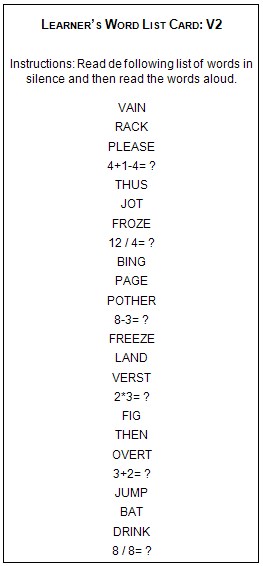
Figure 1. Learner’s word list card
Quantitative Instrument 2: Brainteaser. Based on the argument that learners’ cognitive capacity for the simultaneous processing of meaning and form is limited, a meaning-oriented task was also implemented. This task would allow for a documentation of the effectiveness of explicit phonological instruction when students were engaged in meaning transaction, and thus, would have limited time and cognitive resources for the conscious retrieval of pronunciation knowledge. Brainteaser, a guessing game, was designed to be such a task.
The task consisted of the above-mentioned Brainteaser guessing game, in which a definition was read to the students; then, the students needed to pick from a word list, the word which matched the definition they had hear read. The word guessed included a target phone. This instrument was adapted from a study conducted by Lyster and Izquierdo (2009). Two versions of this Word List instrument were created. Six countries and three words which did not include any of the target phones were included as distracters that would provide students with a break from the pronunciation of the target sounds.
This instrument consisted of two sheets: The Tester’s Brainteasers Card containing the word definitions, or “Brainteasers,” which were read to the testees. The second sheet, the Learner’s Brainteaser Card, contained the instructions and the target words arranged in columns.
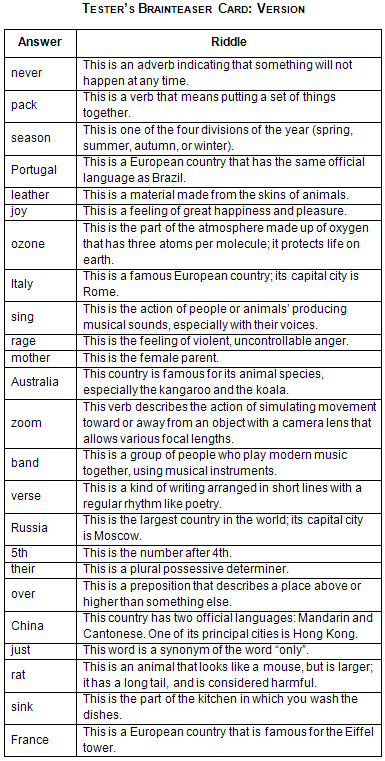
Figure 2. Tester’s brainteaser card

Figure 3. Learner’s brainteaser card
In individual audio-recorded sessions, the participants completed the Brainteaser and Word List tasks before the 16 weeks of phonology instruction, and after it. To counter-balance the implementation of the instrument versions, during the Pretest, 50% of the participants were given Version 1 of both instruments, while the other 50% received Version 2. For the Posttest, the versions were alternated. Analyses of variance conducted on the results revealed no significant differences between the results obtained for the two versions at either of the testing times; therefore, no distinction was made between version results in the statistical analyses.
Qualitative Instrument 1: Teacher’s Log. This instrument was designed to document the frequency with which the teacher taught the target phones, as well as the type of task in which the phones were taught. The instrument consisted of a grid with six columns. In the first column, the date and the activity implemented had to be stated; at the top of the each of the five remaining columns, the phonetic representation of the target sounds was presented. Below each sound, a space was provided for the teacher to write a brief description of the activity whereby the sound was taught. The teacher filled out this form after each instructional session.
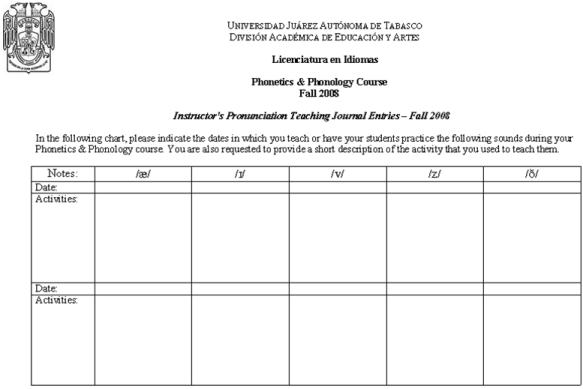
Figure 4. Teacher’s log
Qualitative Instrument 2: Observation Sheet. This instrument was adapted from Spada and Fröhlich’s (1995) observation scheme, and was used to document the instructional tasks implemented in the classroom, as well as the frequency with which learners’ attention was directed toward the target sounds. This instrument was composed of two pages; the first page contained the instructions for the observer. Figure 5 shows that on the second sheet, the observer needed to indicate every time the instructor paid attention to the target sounds, and whether this sound had been taught during a form-oriented or a meaning-oriented task. Form-oriented tasks are tasks that explicitly draw students’ attention to phonological features without a communicative context.
The following form-oriented tasks were shown for the observer to tick: Explanation of phone features (explanation of the place and manner of articulation for consonants; backedness, height and laxness for vowels); Demonstration of phone features (teacher demonstrated the features of phones to students); Phone in isolation (teacher produced the phone only); Phone in words (teacher produced the phone in a word); Ss Individual Repetition (teacher asked only one student to repeat the phone/word); Ss Choral Repetition (teacher asked the whole class to repeat the phone/word); Read aloud (teacher and the students read sentences aloud). The meaning-oriented tasks were tasks that drew students’ attention to phonological features during communicative tasks. The following choices were provided for the observer to select: Dialogues, Class Discussion, Other. The observer used this sheet during classroom observations.
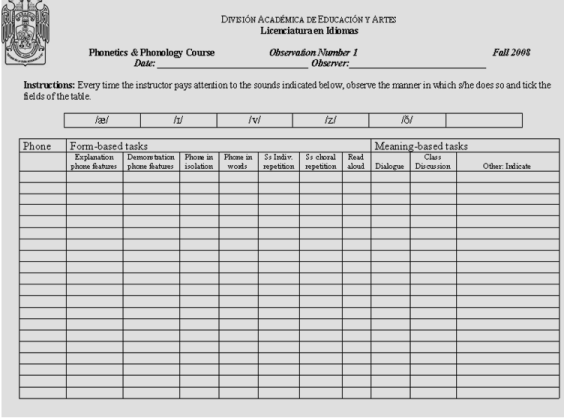
Figure 5. Observation sheet page 2
III. Analysis Procedures and Results
Quantitative Data Analysis Procedures. Two research assistants, working independently, transcribed each audio-recorded oral-production task. The target sounds were transcribed verbatim as pronounced by the participants. The phonetic transcriptions of the target sounds generated by the assistants were compared. When there was a lack of agreement between the transcriptions of the target sound, the first assistant transcribed the target phone for a third time. Then, a score of 1 or 0 was given for the target word, depending on the appropriate pronunciation of the target phone in the word. Three scores were obtained per student per testing time. One score was obtained for the appropriate pronunciation of the six target vowels; this score ranged from 0 to 6. Another score was obtained for the appropriate pronunciation of the nine target consonants; this score ranged from 0 to 9. Finally, one overall score included the addition of the consonant and vowel scores; this score varied from 0 to 15. Independent mixed-model analyses of variance (ANOVA) were conducted to examine pronunciation gains in the Word List and the Brainteasers activities during the period between pretest and posttest within and between proficiency groups. For each task, ANOVAs were conducted for the vowel, consonant, and overall scores. Main and interaction effects were significant when the p-value was smaller than .05.
Global Pronunciation Score Results. The ANOVAs conducted on the List of Word results revealed global pronunciation score gains during the period between pretest and posttest, F(1, 35) = 15.46, p < .001 (See Table I). The results indicated that the L2 proficiency of the learners had not led to differential results, F (2, 35) = .78, p = .469. As regards the overall scores in Brainteasers, the ANOVAs revealed pronunciation gains during the period between pretest and the Posttest, F (1, 35) = 11.2, p = .002 (See Table I), and showed that in these gains, the L2 proficiency had not influenced the results, F (2, 35) = .336, p = .717.
Table I. Overall changes in students’ pronunciation
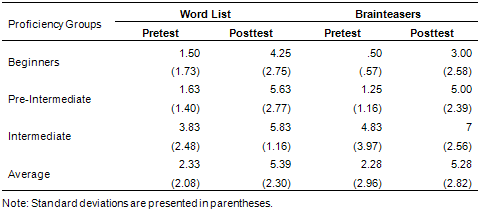
Vowel Pronunciation Score Results. With respect to the pronunciation of vowels, the ANOVAs conducted on the scores from the Word List revealed pronunciation gains during the period between pretest and posttest, F (1, 35) = 7.15, p = .01 (See Table 2), and indicated that all proficiency groups showed the same improvement pattern, as the interaction between the proficiency level and the testing time was not significant, F (2, 35) = .468, p = .631. Regarding the Brainteasers activity, the ANOVAs yielded significant pronunciation gains during the period between pretest and posttest, F (1, 35) = 4.94, p = .034 (See Table II). However, the analyses showed that the L2 proficiency did not have an impact on such gains, F (2, 35) = .655, p = .527.
Table II. Changes in students’ vowel pronunciation
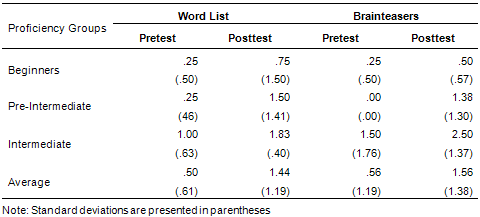
Table III. Changes in students’ consonant pronunciation
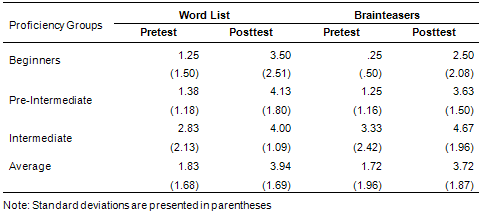
Consonant Pronunciation Score Results. With respect to the pronunciation of consonants, the ANOVAs conducted on the Word List results revealed gains during the period between pretest and posttest, F (1, 35) = 12.06, p = .002, and confirmed that these gains were not influenced by L2 proficiency, F (2, 35) = .747, p = .483. With respect to students' performance on the Brainteasers activity, the ANOVA results showed consonant pronunciation gains during the period between pretest and posttest, F (1, 35) = 11.2, p = .002 and revealed that L2 proficiency had not influenced the gains, F (2, 35) = .35, p = .711 (See Table III).
Qualitative Data Analysis Procedures. On the Teacher’s Log and the Observation sheet, the activities used to teach every target sound were classified as form-based or meaning-based. Then, the frequency with which the teacher taught each phone, using each type of task, was identified.
Table IV. Form-based and meaning-based tasks reported in the teacher’s log
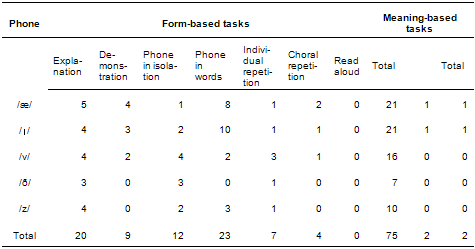
Teacher’s Log Analysis Results. The teacher reported on 17 teaching sessions. He indicated that he had drawn students’ attention to the target phones through form-based tasks on 75 occasions; no meaning-based task was implemented (See Table IV). The form-based task most frequently implemented was Phone in Words; the second most frequent form-based task was the Explanation phone features task, followed by Phone in isolation, and Demonstration of phone features. The tasks implemented with least frequency were Ss individual repetition and Ss choral repetition.
Classroom Observation Results. Nine classes were observed throughout the term. Table V shows that the teacher was observed drawing students’ attention to the target phones 46 times; no meaning-based task was documented. The form-based task Phone in isolation was the one most frequently implemented, followed by the Phone in words and Ss choral repetition tasks. The third most frequent form-based task was Explanation of phone features, followed by Demonstration of phone features, and Read aloud. Finally, the form-based task implemented with least frequency was Ss individual repetition.
Table V. Form-based and meaning-based tasks documented on the observation sheet
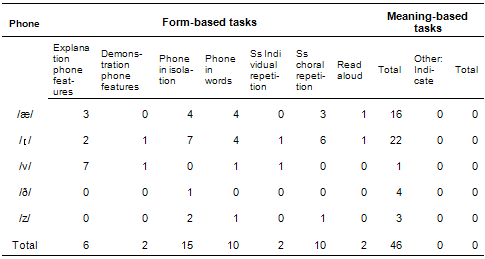
Summary of Findings. This study investigated whether regular classroom-based phonological instruction would lead to differential effects among learners from various L2 proficiency levels. It also looked into whether there would be differential effects obtained between vowels or consonants. The quantitative data revealed that the three proficiency groups improved in the pronunciation of the L2 vowel and consonant sounds on both quantitative instruments after regular classroom-based instruction. The qualitative data pointed to systematized teaching of the target sounds through form-based tasks.
IV. Discussion
Congruent with previous L2 research results, positive instructional effects were observed in our study. The students improved in the pronunciation of vowel and consonant sounds in two different types of tasks. One task allowed students to retrieve knowledge of the phone components of a word (the Word List), whereas the other did the same, but to a lesser degree. While these results confirm the positive effects of instruction, they differed from results of previous studies. In Derwing et al’s study (1998), for instance, students who were instructed on segmentals alone showed improvement in sentence reading, but no improvement on extemporaneous narratives. In our study, however, learners improved in both types of tasks. One explanation for our results is that in our study, both tasks allowed for focusing attention on pronunciation during production. Although the Brainteasers activity aimed at shifting student attention away from L2 phonology, in this task, students did not have to retrieve features of the L2 as morphology, syntax and lexis as they did in Derwing et al‘s study (1998). Moreover, our learners received both segmental and suprasegmental instruction. The suprasegmental instruction provided learners with further practice on segmental pronunciation; hence, they had additional opportunities to assimilate the L2 segmental features.
While previous research examined the effects of explicit phonological instruction on homogeneous L2 proficiency groups, our study examined the effects of instruction on three different proficiency-level groups. The results indicated that students’ L2 proficiency knowledge did not make a difference in phonological improvement. Since adult L2 learners have already developed their cognitive analytical abilities, our learners may have benefited from explicit L2-phonology explanations. Then too, our participants from all proficiency levels were provided with sustained opportunities for practice by means of a wide array of instructional tasks.
The variety of activities utilized for instructing students on segmentals and suprasegmentals could then explain the absence of differential results among proficiency levels and phone types. The teacher employed activities that facilitated perception (e.g., identification of L2 phonology features); production (e.g., repetition); and metalinguistic awareness (e.g., explanations of L2 phonology features). In previous research, this type of instruction has been documented as promoting L2 phonology learning. For instance, Derwing et al (1998) explained that the segmental instruction in their experiment consisted of the repetition and discrimination of individual sound contrasts. For suprasegmental instruction, perception activities were used, with students having to identify the word stress. These activities were in line with those employed by Pennington, Ellis, Lee, and Lock (2002). As shown as in their study, the authors instructed participants through computer-based training, including exposure to sentence samples, perception of differences in sentence intonation, and production of sentences.
The analyses of the instructional tasks implemented by the teacher indicated, therefore, that in the classroom, perception tasks were frequently used in combination with production tasks. The Speech Learning Model (1995) hypothesized that if phonological differences between an L1 and L2 are perceived by the L2 speakers, then the establishment of a new category as a new sound in their phonology repertory is more likely. However if the L2 phone is perceived as an L1 phone, then the sound (being similar, but slightly different) would be not be categorized, and as a result, would not be produced. Strange and Shafer (2008) further outlined that learners need stimuli and task implementation to facilitate the learning of appropriate acoustic structures. Thus, perception tasks may have helped our participants learn phonological aspects that tend to be difficult to acquire because of the L1 characteristics. However, production opportunities were provided; this, according to cognitivist perspectives, means that learning is achieved through explicit instruction and practice (DeKeyser, 2007). The systematized implementation of production tasks may have allowed the students we observed to start proceduralizing the declarative knowledge they obtained from explicit instruction.
Even though, in previous studies, the authors controlled variables such as instruction type and proficiency level, they paid no attention to the students’ L1. Furthermore, the authors did not explain why they had selected the particular target sounds or words. The absence of this piece of information did not allow the authors to determine the extent to which instruction interacted with L1 influence in facilitating the learning of L2 phonology. In our study, however, we selected two vowels and three consonants—English sounds which Spanish speakers find it difficult to learn (Swan & Smith, 1987). The selection of the target phones was based on their degree of difficulty for the participants. The results of our study suggest, then, that explicit instruction can assist adult L2 students in learning L2 phones which they find difficult because of L1 influence.
V. Conclusion
Despite the adult age and L1-L2 phonological differences among our study participants, the results showed that phonological instruction helped them learn L2 pronunciation. This aid seems to have been provided through the implementation of a combination of form-based tasks which exposed these learners to explicit information and extensive practice. Through the explicit tasks, students seem to have benefitted from specific attention to L2 phonology features inexistent in their L1. Then, during the practice tasks, they seem to have had continual opportunities to gain some mastery over the target sounds. Since these types of tasks are form-oriented in nature, more exploration is needed to determine whether better results might be obtained if the teacher were to provide pupils with a larger number of meaning-oriented tasks, and an alternation between meaning-oriented and form-oriented activities, or a combination of these. However, we believe that meaning-based and form-based task implementation would facilitate L2 learning, since it would give varied and numerous contextualized opportunities for practice (See Lyster, 2004).
As regards the influence of age, a significant number of studies has shown that the learner’s age affects pronunciation outcomes (Lightbown & Spada, 2006). Nevertheless, our study concurs with previous research demonstrating that phonological teaching promotes the learning of L2 pronunciation. This learning seems to have taken place at the segmental and suprasegmental level despite cognitive changes in the brain, resulting from age. Moreover, the current study results showed that explicit phonological instruction favored participants’ pronunciation improvement, even in the face of the L1’s negative influence on the learning of L2 phones. The positive effects of the instruction documented in this study are congruent with Derwing and Munro’s (2005) suggestion that learners should receive help in noticing differences between their own sound production and that of native speakers, so as to promote L1-L2 phonological awareness. Our results also suggest that the syllabus for teaching pronunciation could benefit from the integration of L1-L2 awareness tasks. Furthermore, based on the work of Lyster and Izquierdo (2009), teachers should implement interactional strategies such as prompts, to help learners retrieve previously-acquired L1-L2 phonology knowledge during meaning-oriented instruction.
Moreover, the results suggested that our learners, whatever their L2 proficiency, benefited from explicit instruction. This could be related to the fact that adult learners have developed their analytical abilities with age. DeKeyser (2004) pointed out that findings in L2 research show that adults depend on their analytical skills for learning (DeKeyser, 2000; Harley and Hart, 1997). This finding offers evidence that an L2 teacher should provide learners from beginning and more-advanced proficiency levels with sustained classroom-based instruction that will allow them to draw on and use their analytical skills for understanding how the L1 and L2 phonological systems work.
Another instructional factor that seems to have helped our learners, was the varied and systematized opportunities they had. In these they could learn and practice the L2 target sounds through production and perception tasks. It seems that perception activities helped participants to notice L2 phonology aspects they would otherwise have found difficult to perceive. What is more, the instructor provided learners with opportunities to practice production based on earlier instruction which addressed the proper use of the articulatory organs. Likewise, the alternation of segmental and suprasegmental teaching probably provided additional practice that facilitated the learning of L2 target sounds, since participants encountered opportunities to retrieve phonology aspects studied throughout the course. Since our study was limited, however, in terms of the long-term effects of the instructional procedures previously discussed, we plan to do further research on whether a similar type of instruction will help L2 adult learners in the long run, and in more complex, meaning-based tasks. In this new research, we plan to collect further information on the phonology instruction implemented by the classroom teacher, so as to spot those instructional activities that can best motivate the learning of pronunciation.
References
Best, C. (1994). The emergence of native-language phonological influences in infants: A perception assimilation model. In C. Goodman & H. Nusbaum (Eds.), The development of speech perception: The transition from speech sounds to spoken words (pp. 167-224). Cambridge, MA: MIT Press.
Brown, H. D. ( 2007). Principles of language learning and teaching. White Plains, NY: Pearson.
Derwing, T. (2008). Curriculum issues in teaching pronunciation to second language learners. In J. G. Hansen Edwards & M. L. Zampini (Eds.), Phonology and second language acquisition (pp. 347-369). Philadelphia: John Benjamins.
Derwing, T. M. (2003). What do ESL students say about their accents? The Canadian Modern Language Review, 59, 547-566.
Derwing, T. M., & Munro, M. J. (2005). Second language accent and pronunciation teaching: An empirical approach. TESOL Quarterly, 39, 379-397.
Derwing, T. M., Munro, M. J., & Wiebe, G. E. (1998). Evidence in favor of a broad framework for pronunciation instruction. Language Learning, 48, 393-410.
Derwing, T. M., Munro, M. J., & Wiebe, G. E. (1997). Pronunciation instruction for “fossilized” learners: Can it help? Applied Language Learning, 8, 217-235.
DeKeyser, R. M. (2000). The robustness of critical period effects in second language acquisition. Studies in Second Language Acquisition, 22, 499-533.
DeKeyser, R. M., & Larson-Hall, J. (2004). What does a critical period really mean? In Kroll, J. F., & De Groot, A. M. B. (Eds.) Handbook of Bilingualism, Psycholinguistic Approaches (pp. 88-108). New York: Oxford University Press.
Ellis, R. (2003). The Study of second language acquisition. UK: Oxford University Press.
Elliot, R. (1997). On the teaching and acquisition of pronunciation within a communicative Approach. Hispania, 80, 95-108.
Flege, J. E. (1995). Second language speech learning: Theory, findings and problems. In W. Strange (Ed.), Speech perception and linguistic experience: Issues in cross-linguistic research (pp. 233-277). Timonium, MD: York Press.
Harley, B., & Hart, D. (1997). Language aptitude and second language proficiency in classroom learners of different starting ages. Studies in Second Language Acquisition, 19, 379-400.
Hinenoya, K. (2009). Conceptual complexity and accessibility of the article 'the': Is the traditional interpretation of 'the' enough for ESL learners? Unpublished doctoral dissertation, McGill University, Montreal.
Izquierdo, J. (2009). L’aspect lexical et la production du temps du passé en français L2: Une étude quantitative auprès des apprenants hispanophones. La Revue Canadienne de Langues Vivantes-The Canadian Modern Language Review, 65, 587-613.
Izquierdo, J. & Collins, L. (2008). The facilitative effects of L1 influence on L2 tense-aspect marking: Hispanophones and Anglophones learning French.The Modern Language Journal, 93, 349 -366.
Kulh, P. (1992). Psychoacoustics and speech perception: Internal standards, perceptual and anchors, and prototypes. In L. Werner & E. Rubel (Eds.), Developmental psychoacoustics, (pp. 293-332). Washington, DC: American Psychological Association.
Lado, R. (1957). Linguistics across cultures. Ann Arbor: University of Michigan Press.
Lenneberg, E. (9671). Biological foundations of language. New York: John Wiley & Sons.
Lightbown, P. & Spada, N. (2006). How languages are learned. UK: Oxford University Press.
Long, M. (1990). Maturational constraints on language development. Studies in Second Language Acquisition,12, 251-285.
Lyster, R. (2004). Research on form-focused instruction in immersion classrooms: Implications for theory and practice. Journal of French Language Studies, 14, 321-341.
Lyster, R. (2007). Learning and teaching languages through content: A counter-balanced approach. Amsterdam: John Benjamins.
Lyster, R. & Izquierdo, J. (2009). Prompts versus recasts in dyadic interaction. Language Learning, 59, 453-498
Major, R. C. (2008). Transfer in second language phonology. In J. G. Hansen Edwards & M. L. Zampini (Eds.), Phonology and second language acquisition (pp.63-94). Amsterdam: John Benjamins.
Norris, J. M., & Ortega, L. (2000). Effectiveness of L2 instruction. A research synthesis and quantitative meta-analysis. Language Learning, 50, 417-528.
Oller, J. W. & Ziahosseiny, S. M. (1970). The contrastive analysis hypothesis and spelling errors. Language Learning, 20, 183-189.
Pennington, M. C., Ellis, N. C., Lee, Y. P., Lau, L. & Lock, G. (2002). Instructing intonation in a second language: Lessons from a study with Hong-Kong Cantonese undergraduate English majors. Unpublished manuscript.
Scovel, T. (1988). A time to speak: A psycholinguistic inquiry into the critical period for human speech. Cambridge, MA: Newbury House.
Skehan, P. (1998). A cognitive approach to language learning. New York: Oxford University Press.
Spada, N. & Frölich, M. (1995). The communicative orientation of language teaching observation scheme: Coding conventions and applications. Sydney: National Centre for English Language Teaching and Research, Macquarie University.
Swam, M. & Smith, B. (1987). Learner English: A teacher’s guide to interference and other problems. Cambridge: Cambridge University Press.
Trofimovich, P. & Gatbonton, E. (2006). Repetition and focus on form in processing L2 Spanish words: Implications for pronunciation instruction. The Modern Language Journal, 90, 519-535.
VanPatten, B. (2004). Processing instruction: Theory, research, and commentary. Mahwah, NJ: Lawrence Erlbaum Associates.
1 This study was funded through research funding granted to the second author by the Universidad Juárez Autonoma de Tabasco through the Institutional Research Development Program (UJAT-2008-C04-02). Parts of this study were presented at the Modern Language Research Forum of the Universidad Juárez Autónoma de Tabasco in May 2010. We are grateful to the participating teacher and students and to the following research assistants for contributions to various phases of this research: Gabriela Fabiola Velasco Vazquez and to Angel Morales Jimenez. We gratefully acknowledge the anonymous journal reviewers for their helpful comments on earlier versions of this article.
2 The names of the RAs who assisted the authors during the organization of the current project and the project funding agency will be acknowledged during the final manuscript submission.
Please cite the source as:
Morales Pech, D. & Izquierdo, J. (2011). L2 phonology learning among young-adult learners of English: Effects of regular classroom-based instruction and L2 proficiency. Revista Electrónica de Investigación Educativa, 13(1). Retrieved month day, year from: http://redie.uabc.mx/vol12no2/contents-moralesizquierdo.html
![]() / with difficulty because German contains equivalent or similar phones. However, the participants produced the sound /æ/ with success, as this sound did not have a related phone in German. In light of the results of this and other studies, Derwing and Munro (2005) have suggested that English instructors provide learners with opportunities to notice how the phonological system of their L1 differs from that of the L2.
/ with difficulty because German contains equivalent or similar phones. However, the participants produced the sound /æ/ with success, as this sound did not have a related phone in German. In light of the results of this and other studies, Derwing and Munro (2005) have suggested that English instructors provide learners with opportunities to notice how the phonological system of their L1 differs from that of the L2.








